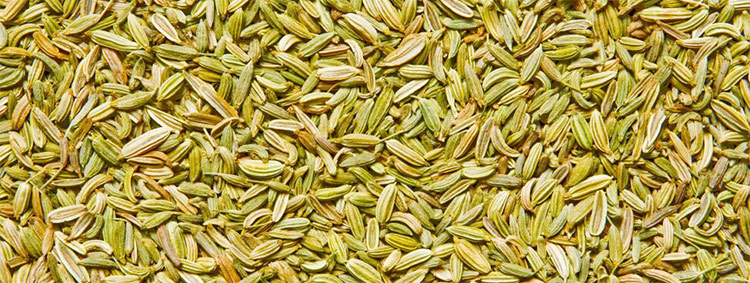Sweet Fennel Essential Oil
Foeniculum vulgare

Description
Sweet Fennel Essential Oil contains approximately 70-80% trans-Anethole (an ether) and is known for its ability to assist with digestive and menstrual concerns and for its diuretic, mucolytic and expectorant properties. Please refer to the Uses section below for more possible applications.
Emotionally, Fennel Essential Oil can be helpful in blends intended to help provide mental stimulation, clarity and focus. Robbi Zeck writes that "The sweetness of Fennel assists in completing things that are unfinished or requiring further attention in your life... Fennel keeps your mind concentrated on a particular direction and accesses the quiet containment of continuity." [Robbi Zeck, ND, The Blossoming Heart: Aromatherapy for Healing and Transformation (Victoria, Australia: Aroma Tours, 2008), 79.]

It has been said by some that Fennel Essential Oil can help balance fluid retention and may help curb the appetite, and therefore, may be helpful in inhalation blends to support weight loss.
Aromatically, Fennel Essential Oil is sweet, yet somewhat spicy and peppery with a licorice-like (Anise) note. It is a top to middle note and is sometimes used within natural fragrancing. It blends well with essential oils in the wood, citrus, spice and mint families.
Due to its trans-Anethole content, Sweet Fennel Essential Oil requires careful use (as do all essential oils). See the Safety Information section below for more information.
Fennel Essential Oil Benefits and Uses
- Digestive Disorders
- Dyspepsia
- Gastrointestinal Spasm
- Flatulence
- Nausea
- Constipation
- Irritable Bowel Syndrome
- Abdominal Spasm
- Menstrual Problems
- Menstrual Cramps
- Premenstrual Syndrome
- Fertility
- Endometriosis
- Menopausal Symptoms
- Cellulite
- Fluid Retention
- Heavy Legs
- Bronchitis
- Respiratory Conditions
- Parasitic Infections
Source: Valerie Ann Worwood, The Complete Book of Essential Oils and Aromatherapy, 25th Anniversary Edition (Novato, CA: New World Library, 2016, 588.]
Botanical Name
Plant Family
Common Method of Extraction
Steam Distilled
Plant Part Typically Used
Color
Clear with a Faint Yellow Tinge
Consistency
Thin
Perfumery Note
Top/Middle
Strength of Initial Aroma
Medium - Strong
Aromatic Description
Sweet Fennel Essential Oil smells sweet, peppery and anise/licorice-like.
Major Constituents
- (E)-Anethole
- (+)-Limonene
- Fenchone
- Estragole
- a-Pinene
See Essential Oil Safety for a more complete list of typical constituents.
Source: B.M. Lawrence, Essential Oils 1988-1991 (Wheaton: Allured Publishing, 1995), 199. K.H. Kubeczka, Essential Oils Analysis by Capillary Gas Chromatography and Carbon-13 NMR Spectoroscopy, Second Edition. (Chichester: Wiley, 2002). Sources cited in Robert Tisserand and Rodney Young, Essential Oil Safety (Second Edition. United Kingdom: Churchill Livingstone Elsevier, 2014), 277.
Sweet Fennel Essential Oil Safety Information
Tisserand and Young indicate that Fennel Oil may interact with medication, and that it may inhibit blood clotting. They precaution to avoid use of the oil topically if it has oxidized as skin sensitization is more likely. Their contraindications include pregnancy, breastfeeding, endometriosis, estrogen-dependent cancers, and children under 5. Their dermal maximum is 2.5%. Reading Tisserand and Young's full profile is recommended. [Robert Tisserand and Rodney Young, Essential Oil Safety (Second Edition. United Kingdom: Churchill Livingstone Elsevier, 2014), 277.]
General Safety Information
Do not take any oils internally and do not apply undiluted essential oils, absolutes, CO2s or other concentrated essences onto the skin without advanced essential oil knowledge or consultation from a qualified aromatherapy practitioner. For general dilution information, read AromaWeb's Guide to Diluting Essential Oils. If you are pregnant, epileptic, have liver damage, have cancer, or have any other medical problem, use oils only under the proper guidance of a qualified aromatherapy practitioner. Use extreme caution when using oils with children and be sure to first read the recommended dilution ratios for children. Consult a qualified aromatherapy practitioner before using oils with children, the elderly, if you have medical issues or are taking medications. Before using this or any essential oil, carefully read AromaWeb's Essential Oil Safety Information page. For in-depth information on oil safety issues, read Essential Oil Safety by Robert Tisserand and Rodney Young.
Shelf Life
Important Information About the Profiles
The essential oil information provided on AromaWeb is intended for basic educational purposes only. The references to safety information, test results, constituents and percentages is generalized information. Essential oils can vary greatly in composition. The data is not necessary complete and is not guaranteed to be accurate. The essential oil photos are intended to represent the typical and approximate color of each essential oil. However, essential oil composition and color can vary based on harvesting, distillation, age of the essential oil and other factors. Profiles for several CO2 Extracts and absolutes are included within the directory, and are denoted as such.
